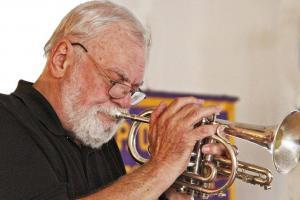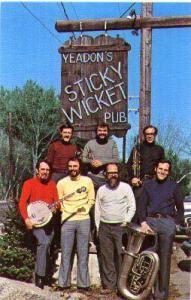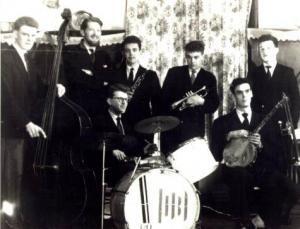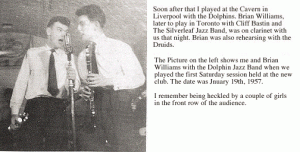 Tony Pringle, 81, May 3rd, in Massachusetts from complications of heart disease.
Tony Pringle, 81, May 3rd, in Massachusetts from complications of heart disease.
He was the best musical import America ever received from Liverpool. In 1957, while still training for his day job in telecommunications, he formed The Druids Jazz Band. They became the house band at The Cavern, a basement jazz club in Liverpool. The Cavern was friendly to skiffle bands, so they also hosted the Beatles while they were still The Quarrymen. He moved to the US in 1967 and within two weeks was part of the Exit Jazz Band with Stan Vincent, Stan McDonald, and Gil Roberts.

In 1969 he joined The Black Eagle Jazz Band, led by Tommy Sancton. Initially he played trumpet but soon switched to cornet. The Black Eagles separated after a final performance at the 1971 New Orleans Jazz and Heritage Festival. Soon after a group of former Eagles began appearing as the Boston Bayou Jazz Band. With some additions they would become The New Black Eagles Jazz Band. The original lineup was Tony Pringle, Pam Pameijer, Peter Bullis, Eli Newberger, Stan Vincent, Stan MacDonald, Bob Pilsbury and Norm Stowell. On September 30, 1971 the NBEJB played their first show under that name on the Peter Stuyvesant, a ship moored beside the Pier Four Restaurant in Boston Harbor. They quickly began a regular appearance at Yeadon’s Sticky Wicket Pub and a legend was born.
In the decades to follow The New Black Eagle Jazz Band became one of the best known and most respected Dixieland bands in the country. Especially around the North East. They recorded albums on their own Black Eagle Label and others. Pringle’s playing, influenced by Bunk Johnson, Kid Howard, and others, gave the band a catchy old time feel.
Despite a strong public association with the Sticky Wicket, and other regular pub gigs, the NBEJB has played all over the world at festivals and concert halls. The have appeared in settings where they were the only offering that wasn’t classical music. The band has been part of PBS documentaries and played with historic figures of jazz.
Pringle’s contribution as a guide for the band, on stage and off, cannot be overstated. They have had only limited lineup changes in almost 50 years. Pringle’s friend Ron L’Herault said in a remembrance:
“From the first moment I heard Tony play, I knew I was in the presence of a great
horn player. And as I listened to the New Black Eagle Jazz Band more and
more, I came to realize that he was an equally gifted leader of the band.
He could build incredible excitement without increasing volume, altering
tempo or changing key. By the time he piloted the band to the out chorus,
the audience, me included were about ready to burst with joy. I’ve never
heard anyone else do what he did…”
Pringle wrote the following essay about his early life in jazz for the “reminiscing” page of Jazz North West UK.
GETTING STARTED IN JAZZ
by Tony Pringle
I was born on 12th December 1936 in a bungalow named “The Anchorage” in the village of Greasby on the Wirral Peninsula which is just across the river from Liverpool, England. The big news at the time was the abdication of King Edward VIII, but I was unaware of such goings on. If the Pringle family would have had their way I would have been named, as the eldest son of the eldest son, John Crester Pringle. My mother Isabel Edith Florence Laverick-Platt either had a warm spot for Anthony Eden or felt that as she had so many names someone should atone, hence Anthony is my one and only Christian name. Over the years I have found that I am only called Anthony by teachers and managers when I am in trouble, and more lately, by telemarketers trying to sell me something. Tony is much preferred as a mode of address.
In 1939, right at the start of World War II, my parents broke up and my father took me to live with my grandparents – his parents. Looking and thinking back I am amazed that they took me on. They had brought up nine children of their own and along came me just as they were in sight of their youngest heading off for pastures new. My dad and grandfather were away somewhere in Wales working at a secret armaments factory under a mountain. My grandmother and my 6 aunts did a wonderful job of looking after me, for which I was not always as grateful as I should have been, but certainly am now.
Sometime soon after that a German bomb landed in our garden and we took off to our cottage in Wales, away from the bombing. While we were away another bomb destroyed the block of houses at the end of our road and blew all the windows out of our house, the soot came down the chimneys and all my childhood toys were lost.
Apart from that excitement life was, as I remember it, very good. My grandmother played piano and my youngest aunt had a record collection. I sort of remember Glenn Miller, but have vivid recollections of “Woodman Spare That Tree” and Pistol Packin’ Mama”. I started piano lessons, but gave them up because my friends called me a sissy. I played a little piano by ear – I would pick out Handel’s Largo and other tunes that my grandmother played. At times my Dad visited and I remember him at times trying guitar and piano accordion – it mustn’t have taken because it didn’t last. Lastly, there was my grandfather, who would from time to time break out with politically incorrect tunes recalled from his earlier days or from some popular music hall artist. At some point someone gave me a Ukulele – my favorite tune was Drink To Me Only and I could play some George Formby numbers – no jazz there!
My introduction to the music that I love came about totally out of the blue!
I have always thought that being a fan of New Orleans style or traditional jazz was like catching a very obstinate bug – once you’ve got, it stays with you forever. I swear it feels like that is the way it has been with me. I can still remember my friend Dave Burnley calling me to come over to his house to hear these great records given to him by his uncle. This was back in 1955 or so, and he had been given a bunch of 78s. I can remember like it was yesterday my first experience with real New Orleans jazz – the first sides that I listened to were Jelly Roll Blues and Doctor Jazz by Jelly Roll Morton his Red Hot peppers followed by Just A Closer Walk With Thee and High Society by Bunk Johnson on the HMV label.
Wow! I could not believe that music like this ever existed. This was nothing like Sid Phillips on BBC radio or what I had heard on Voice of America over short wave radio. On the way home I went into Strothers, our local record and music store, there I found a copy of 29th and Dearborn and Sweet Mumtaz by the Luis Russell Hot 6. I immediately recognised names like George Mitchell on cornet (still one of my favourites), “Kid” Ory, and Johnny St. Cyr. I bought it and headed home – you have to understand that at this time I had no way to play my find. The next week I bought a Garrard turntable and then went to the Army Navy store where I purchased a pair of earphones that looked like they dated back to the second world war. I hooked it all together and for weeks would just play the two sides – I was really hooked.
Soon after I traded in my old Ukulele, that I had played for some time, for a banjo and started to learn to play jazz tunes. I also had a Guitar and because of this I used Guitar tuning on my banjo – not the best approach. Eventually I dropped both these instruments and only ever played one band job on banjo as a substitute with another band – after one set I had cramp in my left hand. At the end of the evening I retired from rhythm section work.

Shortly after my indoctrination into jazz someone talked me into going to hear a local band. The Panama Jazz Band was playing at the Roycroft Hall in Wallasey not too far from where I lived with my grandparents. I can remember my first impression when they started playing. I was aghast. The trumpet player, a very nice guy, had to be the worst trumpet player that I have ever heard. I am sitting there thinking that I could do much better myself. This was based on nothing at all, my never having tried to play any wind instrument. The evening was saved when another trumpet player arrived to much excitement. It was Ken Sims who would later be with Cy Laurie’s and then Acker Bilk’s bands. When he played it sounded great and I decided there and then to get a cornet. The same week I bought a copy of the Melody Maker newspaper and sent away for a cornet. It cost £12, did not have a spit valve and came in a beautiful curved wooden case with exquisite brass fittings.
I started to teach myself to play. I spoke with Ken Sims who recommended a teacher, but after a few lesson I stopped going to him. He told me that playing jazz would spoil my tone. A clarinet player at work taught me something about chords and I started to learn some tunes. At some time in 1956 or so I got an offer to join the Dolphin Jazz Band. After my first gig I walked home with Brian Williams who had played clarinet with the band and he introduced me to Roy Penny and Vic Sanderson. The next night these guys came over to my house and we had a session. Vic had a lousy banjo so I loaned him mine and taught him some chords and off we went. Brian played like George Lewis on the Bunk Victors and Roy played like Jim Robinson. We called ourselves the Druids Jazz Band. We must have driven my grandparents crazy practicing every night of the week and then going to the local pub to talk about the music. They were great times.
We had our first gig soon after. We were booked to play at a workingman’s club on the dock road Birkenhead, the neighbouring town. We only knew about 12 tunes and half of them were spirituals and we used a Tea Chest bass with one string! The gig lasted 5 hours and I lost track of how many time we repeated ourselves. The audience was not entranced.

Pretty soon we added drums and string bass (this last replacing the Tea Chest bass) to the Druids Jazz Band and in 1958 we became the resident Saturday night band at the Cavern and on Fridays at the other big jazz club in Liverpool – The Mardis Gras. We played intervals for Ken Colyer, Acker Bilk, Sandy Brown and other leading bands up from London. That’s how I got started! In 1967 I immigrated to USA, in 1969 I met Tommy Sancton and we started The Black Eagle Jazz Band and in 1971, After Tommy and Jim Klippert departed us, we formed the New Black Eagle Jazz Band, but that’s a story to be told in another hand dodger.
Related Story: Remembering Tony Pringle
Related Story: New Black Eagles Remain Aloft
Joe Bebco is the Associate Editor of The Syncopated Times and Webmaster of SyncopatedTimes.com






















